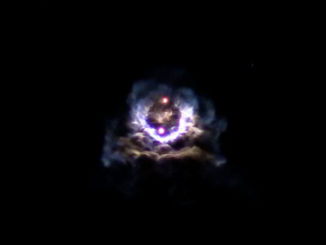
Japan’s HTV supply ship fell to Earth on Sunday more than a week after leaving the International Space Station, burning up in the atmosphere after officials gave up on an experiment looking into ways to remove space junk from orbit.
The barrel-shaped spacecraft, measuring 30 feet (9.2 meters) long and 14 feet (4.4 meters) wide, departed the space station Jan. 27 after delivering more than 9,000 pounds (about 4.1 metric tons) of supplies, experiments and six lithium-ion batteries to begin a refresh of the research lab’s electrical system.
The mission launched from Japan on Dec. 9 aboard an H-2B rocket.
Astronauts replaced the cargo with trash inside the HTV’s pressurized cabin, and the station’s robotics system placed nine no-longer-needed batteries into the logistics craft’s external cargo bay before the departure.
The mission was Japan’s sixth HTV resupply mission — nicknamed Kounotori 6, using the Japanese word for “white stork.”
Shortly after leaving the space station, the HTV was supposed to release an electrodynamic tether measuring nearly a half-mile (700 meters) long for a research experiment to gauge such a device’s effectiveness at helping clear low Earth orbit of space junk.
But the experiment encountered problems, Japanese scientists said, and the tether was never unreeled.
One of four bolts holding the end mass — a structure fixed to the end of the tether — to the HTV’s main body apparently did not release as planned Jan. 28, according to a statement by the Japan Aerospace Exploration Agency.
JAXA said telemetry data from the spacecraft indicated one of the bolts did not disengage after an initial release command, but data showed the bolt disconnected a few minutes later after further commands.
A couple of hours later, an attempt to extend the tether did not work. JAXA said ground controllers tried to unfurl it multiple times without success.

The Kounotori Integrated Tether Experiment, or KITE, was intended to study the behavior of a tether made of strands of aluminum and stainless steel wire, similar to devices that could remove space debris from orbit in the future.
Space debris experts say electrodynamic tethers like the one carried on Kounotori 6, which had a thin coating of lubricant to encourage electric conductivity, could offer a way to de-orbit derelict rocket stages and aging satellites without expending precious propellants.
The interaction between an electrodynamic tether and the Earth’s magnetic field should generate enough energy to change an object’s orbit, eventually allowing it to burn up in the atmosphere.
Electrodynamic tethers have been tested in space before on two space shuttle missions in the 1990s. The tethers extended from the shuttle’s payload bay never reached their intended length — one tether jammed and another broke — but engineers gathered useful data to apply to future missions.
Once the tether aboard Kounotori 6 fully deployed, the rendezvous sensors and a camera on the HTV were designed to track the motion of the tether and its end mass. A field emission cathode was supposed to generate an electrical current to run through the tether to check its interaction with Earth’s magnetic field.
Despite the tether snag, JAXA said the cathode released electrons as designed, allowing experimenters to verify the performance of that piece of the tether demonstration.
Ground controllers only had about a week to conduct the tether experiment before the HTV’s scheduled re-entry Sunday.
JAXA confirmed the spacecraft plunged back into the atmosphere and burned up over the ocean around 1506 GMT (10:06 a.m. EST) Sunday.
Email the author.
Follow Stephen Clark on Twitter: @StephenClark1.



